(where NOTHING is as black & white as we want it to be)
On May 7, 2019, the San Juan County commissioners gathered at their regular bi-monthly meeting to discuss an array of controversial matters (If its San Juan County, it must be controversial). A packed room listened to Kenneth Maryboy, Willie Grayeyes, and Bruce Adams debate the merits of a proposed Love’s Truck Stop in Spanish Valley. They heard the commissioners discuss the recent emergency appointment of David Everitt as the county’s new administrator.
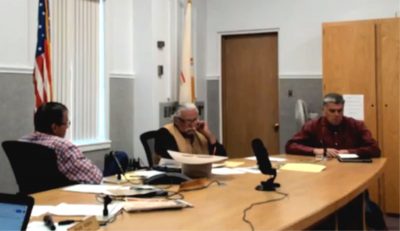
During the public comment period, a variety of citizens expressed their own support or misgivings. Among them was former commissioner Phil Lyman, now a Utah state legislator. Lyman spoke briefly, and in support of the Love’s truck stop. He argued that the planned project would be a tremendous tax boost for the county and urged the commissioners to consider its advantages as well as its liabilities. Most of the other commenters were relative newcomers to Spanish Valley who had moved there for the area’s intangible qualities. These migrants came to escape the noise and chaos of their city homes, and had little interest in the truck stop’s more practical benefits to an economically depressed county.
Lyman finished his remarks and, without discussion, returned to his seat in the audience. But when the last of the citizens had commented, Commissioner Maryboy paused a moment and then spoke in his soft and deliberative manner, addressing his remarks to the former commissioner. He said:
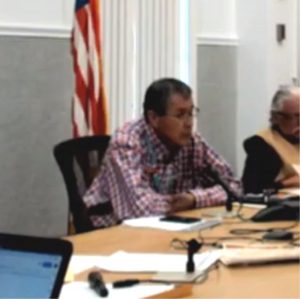
“Phil Lyman…We’ve known each other for quite sometime and we did a lot of projects. I do respect you for that, and I do respect your wisdom at times. And development on economic issues…(we) need those economics. But I think it would be wise to consult with the impacted areas of the community before anything is being recommended. I think that would be a wise decision. (But) I do take your recommendations to heart.
“We will continue to work..At the higher level you are (in state government), I will be communicating with you on a lot of these projects. Also some of the upcoming activities that will be beneficial to the county and also impacting as well. So thank you very much…My brother. I believe that’s what we called each other at one time. It may not be appropriate to your world, but to me, it’s ‘my brother.’ Thank you very much.”
From the audience, Phil Lyman nodded and replied, “It is appropriate.”
(Video of this exchange is available on Facebook HERE. Remarks by Commissioner Maryboy to Rep. Lyman begin at approx 1:00:30.)
During what had been a raucous and emotional meeting, torn by division and disagreement, you could have heard a pin drop. There are no more polarizing figures in San Juan County than Maryboy and Lyman.
The gathered group may well have been collectively thinking, These guys LIKE each other? It’s important to understand how Maryboy and Lyman are perceived by their allies and their adversaries.
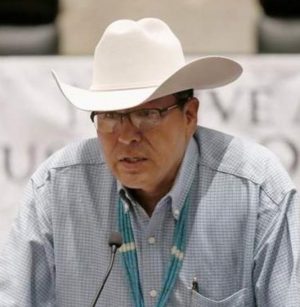
To the Environmental Left, Kenneth Maryboy (and his brother Mark) are their guys. To allies, Kenneth is a champion of the original 1.3 million acre Bears Ears National Monument, the passionate opponent of damaging energy extraction in the county, and the defender of public lands for the preservation of their scenic qualities. Kenneth and Mark are their symbols of Native American resistance to the encroachment of white dominance in San Juan County. Their side believes the Maryboys seek to reclaim the land of their Navajo ancestors, who first came to the area more than three centuries ago. Support from progressives is far-reaching.
To the Left, Phil Lyman is the closed-minded, racist, land destroying, white Mormon “convicted criminal” who seeks to destroy every inch of his county in pursuit of oil, gas, uranium or whatever commodity can be plundered from the earth.
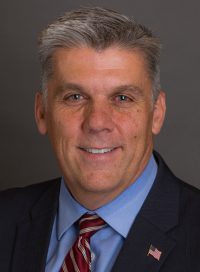
To the Conservative Right, Phil Lyman is the unrivaled leader of their cause. He is The Man who stood up to what they perceive to be the never ending abuse and overreach of the federal government. He has opposed the powerful “progressive/environmental” proponents of a massive Industrial Tourism economy and believes the county’s energy potential is the key to its prosperity. His efforts to preserve the heritage of the land his Mormon ancestors settled, almost 150 years ago, have made Phil Lyman the Hero of San Juan County Conservatives and Beyond.
To the Right, Kenneth Maryboy is the power hungry, hypocritical pawn of white progressive environmentalists. They believe he does the bidding of powerful “green” billionaires with the hope of making a ton of money along the way. While Maryboy leads the county as chairman of its governing body, his critics believe he is circumventing the very laws he was elected to uphold, in aggressive pursuit of his own agenda.
That’s how both “sides” see these men.
And yet, now, to the stunned amazement of the room, Maryboy and Lyman were engulfed in a moment of mutual respect and affection. Most would have assumed they loathed each other. The exchange defied the popular perception promoted by the media and most of the political propagandists on both sides of the debate.
But history offers a considerably different view.
As recently as a decade ago, Kenneth Maryboy and his brother Mark (also a former SJC commissioner) were not just allies with Phil Lyman, they were all willing allies. Even more stunning was the clear conviction by Maryboy that San Juan County government cared more for its Utah Navajo residents than the government of the Navajo Nation.
At stake was the Utah Navajo Trust Fund. The monies paid into the fund were generated over the years by oil revenues predominantly produced by wells in the Aneth district of the Navajo Reservation, within the State of Utah. But as Kenneth’s brother Mark Maryboy noted in a story for “Counterpunch” by writer Andrea Peacock, the Utah Navajos were all but ignored by the leaders of the tribe.
Maryboy told Peacock:
“The Utah Navajos have always been a stepchild to the Navajo Nation from day one….In the beginning of the Navajo Nation government, the Navajo Nation rejected the Utah Navajos saying that ‘They’re not Navajos, they’re too far north, they must Ute or something.’ It wasn’t until the oil, the great quantity of oil was discovered in Utah that they said ‘Yeah, they’re our people.’”
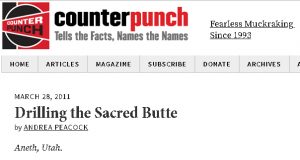
And Peacock noted:
“To make matters worse, the Utah Navajos never got their fair share of the profits…By law, the Utah Navajos were to receive 37-1/2 percent of the royalties, with the rest going to the Navajo Nation. But the Aneth-area Navajos never had control of that money—it was placed in a trust fund, managed nominally by the state but mostly funneled through a private, nonprofit called the Utah Navajo Development Council formed specifically to provide services to Navajos in San Juan County. A 1991 audit by the State of Utah pronounced the trust fund mismanaged, the money wasted and lacking oversight “to the point that effective policy direction and accountability have not existed.”
The debate over the use or misuse of the trust fund went on unabated for years. Finally in 2008, the U.S. Congress stepped in, hoping to bring resolution. A San Juan Record article from June 8, 2008 reported that, “Two options are under consideration for the fund, including giving the fund to the Navajo Nation or creating a private, non-profit organization to administer oil and gas royalties.”
And the article added that, “San Juan County Commissioner Kenneth Maryboy played a key role in the recent activities surrounding the Trust Fund. Commissioner Maryboy, Mark Maryboy and Phil Lyman made the trip to Washington to be a part of the Congressional hearing.”
A year later, more hearings were conducted and interested parties from the Navajo Reservation and San Juan County traveled to Washington to discuss the merits and drawbacks of a proposed bill by then-Senator Bob Bennett. Bennett’s bill would have allowed a non-profit corporation to administer the trust fund, instead of the Navajo Nation. On December 9, 2009, a Senate Hearing conducted by the Committee on Indian Affairs heard testimony from Kenneth Maryboy on behalf of that corporation, the Utah Dineh Corporation.
(I’m including long excerpts here and a link to the entire hearing below)
Here, in part, is Kenneth Maryboy’s statement:
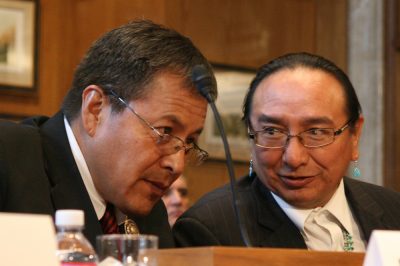
“San Juan County believes that the Navajo Nation government, which is located in Window Rock, Arizona, and provides few if any government services to Utah Navajos, does not have the best interest of Utah Navajos at heart when it asserts a vague argument of tribal sovereignty to wrestle away control of the Utah Navajo Trust Fund from Utah Navajos.
“The Navajo Nation’s heretofore disinterest in its own members who reside within the Utah strip of the Navajo Nation is the very reason why San Juan County has stepped up to the plate to deliver essential government services to Utah Navajos who live within the 1,550,000 acres of the Navajo reservation that constitute the southern region of our 821 square mile county.
“San Juan County has provided law enforcement, fire protection, emergency medical services, senior services, road maintenance, telecommunication and water services to the seven Utah Navajo chapters because the tribe in Window Rock does not. (emphasis added)
Navajo Nation President Ben Shelly spoke in opposition to the bill:
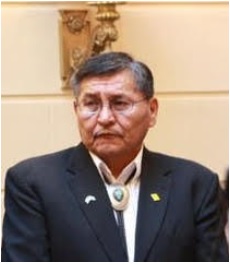
“We strongly disagree with S. 1690. The Navajo Nation wants to be the trustee of the Utah Navajo Trust Fund. We want to work with Congress, this Committee and the Utah delegation to make the Navajo Nation a strong, accountable, and transparent trustee.
With me is Mr. John Billie, the President of the Aneth Chapter and the Chairman of the Navajo Utah Commission. Mr. Billie is here to inform the Committee that the Aneth Chapter does not S. 1690 and is available to answer any questions.
The Navajo Nation is adamantly opposed to S. 1690. Chairman, again, we adamantly oppose S. 1690.
This bill would give the Federal trust responsibility for royalties from Navajo Nation mineral leases to a non-profit corporation. This corporation did not exist when this bill was introduced.”
Billie then offered his own blistering attack against the proposed Utah Dineh Corporation, the Maryboy brothers, and Phil Lyman. In part Billie told the committee:
“As an elected leader of the Navajo people, I took an oath to uphold the laws of the Navajo Nation and represent the people to the best of my ability. It is due to this oath that I took offense at some of Council Delegate Kenneth Maryboy’s remarks including utilization of a Navajo phrase spoken in the Navajo language at the beginning of his introduction. Mr. Maryboy used a Navajo phrase generally meaning he was addressing the enemy and going into battle. Many Navajo people listening to the hearing’s webcast were offended. This is a phrase utilized by Navajo medicine people in ceremonies preparing warriors going off to war against a real enemy. Many found this disturbing and inappropriate because it was basically a threat to individuals who were not the enemy. Mr. Maryboy was elected to his duel capacity as Navajo Nation Council Delegate and San Juan County Commissioner by the Navajo people of Utah. Mr. Maryboy owes an apology to the Navajo people, members of the Senate Indian Affairs Committee, San Juan Commission, and people of Utah.
Billie’s testimony identified the Dineh Corporation as a “Special Interest Group” and continued:
The special interest creating the Utah Dineh Corporation include former tribal leaders, a non-Indian CPA, and Zions Bank. Mark Maryboy, one of the former leaders worked exclusively with CPA Phil Lyman to develop the Corporation with ultimate intent to install the two individuals as CEO and CFO. The plan was outlined in an unsuccessful request for funding from the state’s Utah Navajo Revitalization Fund. Zions Bank of Utah revealed its interest with a contribution of $10,000 in this application. Phil Lyman also owns an investment firm and has created strong ties with Zions Bank. Mr. Lyman basically created the Corporation single-handedly. Mr. Lyman also conducted a media campaign with misinformation and made-up quotes of support. The Navajo people found Mr. Lyman’s cavalier attitude about tribal sovereignty equally disturbing. The board for the Dineh Corporation was hand-picked supporters–there was no process in selecting the board.
(To read the transcript of the entire hearing, click HERE)
The members of the Congressional committee quizzed the Navajo representatives about their divergent points of view and the obvious rancor and distrust that existed between the representatives of the Navajo Nation and supporters of Senator Bennett’s bill, including Maryboy and Bennett himself.
Ultimately Congress could not resolve the differences and Bennett’s bill never made it out of committee. In 2011, Senator Hatch introduced similar legislation, S. 1327, that would have “transferred certain authority and resources to the Utah Dineh Corporation,” but again the bill died in committee. A decade later, the Utah Navajo Trust Fund is still managed by a Board of Trustees appointed by the State of Utah, mainly because the various factions within the Navajo Nation could never reach anything close to a consensus on who should control the trust funds. And the Maryboys still object to the way the Navajo Nation treats its Utah tribal members.
—
Nothing is as black and white in San Juan County as it seems…
A couple years ago, I fell into a nasty argument on facebook over an event that occurred a decade ago. This time it was the words of Mark Maryboy that provided the compassionate nuance so badly needed in an otherwise never-ending polarizing narrative.
On the usually combative facebook page of a usually polarizing acquaintance, I came upon an ongoing free-for-all about San Juan County’s sheriff. Rick Eldredge had recently been investigated by the state attorney general over allegations of improper behavior by a disgruntled ex-deputy (The sheriff was later completely exonerated and in 2018 was named the Utah Sheriffs Association Lawman of the Year).
But the first rule of hate mongering social media is that nobody is innocent until proven guilty, unless he or she is one of your own. Otherwise, the mud can fly freely.
For reasons that are beyond me now, I jumped into the discussion. Someone brought up the infamous BLM Blanding Raids of June 2009 and the level of discourse took a further plunge.

(For those of you unfamiliar with the event, on June 10, 2009 more than a hundred armed BLM law enforcement officers raided numerous homes in Blanding, looking for protected artifacts. According to a Washington Post article:
Twenty-three men and women were scooped into custody, the fruit of a 2½-year investigation….The locals, accused of pilfering ancient artifacts from the surrounding desert, were charged with violating the federal Archaeological Resources Protection Act and the Native American Graves Protection and Repatriation Act…For Native American groups, the raid was the first step in a much-needed crackdown on looting in a unique archaeologically-rich region. But for others, the handling of the operation became yet another example of federal overreach — one that continues to affect the region today and is reflected in the Trump administration’s policies.
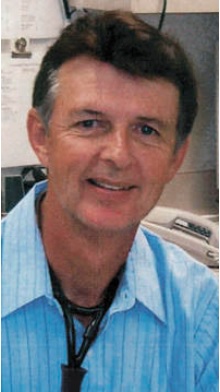
A day after the raids, James Redd, a Blanding doctor arrested in the sweep along with his wife, committed suicide. A week later, Steven Shrader, a collector from Albuquerque, also killed himself. And less than a year after the arrests, the dealer who worked with investigators to set up the defendants took his life as well. The deaths were blamed on the government’s overzealous prosecution.
In the facebook debate, the memory of the “Blanding Raids” was enough for one commenter, founding Torrey House Publisher Mark Bailey, to condemn the entire community–and me too. Bailey wrote in part:
“Stiles the rural victim. In 2009 the court looked the other way and let all of Jim’s way-of-life, busted for grave robbing local buddies off the hook with a slap on the wrist, no time served.”
I tried to point out that even the Blanding Raids had their own complicated and contradictory implications. I replied:
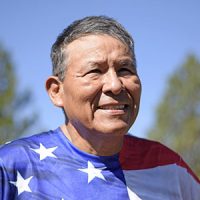
“Mark Bailey… Interesting you should mention the Blanding raids in 2009. In a ‘Salt Lake Tribune’ article from June 13, 2009, here is what Bears Ears NM advocate (and Navajo leader) Mark Maryboy said about those raids, and about Blanding native, Dr. Jim Redd who committed suicide.”
I attached the link and this excerpt from the Salt Lake Tribune:
“Even on the Utah strip of the Navajo Nation, Redd was very much loved, said Mark Maryboy, former San Juan County commissioner and member of the Navajo Tribal Council.
“I’m very sad. Dr. Redd was a good friend of mine,” Maryboy said. “Dr. Redd was one of a kind; he was good to everyone.” Maryboy said federal authorities were heavy-handed in the way they went about enforcing the antiquities law.
“The federal government has a responsibility to protect antiquities,” he said. “But they have a responsibility to protect people, too. Anytime somebody loses his or her life, like Dr. Redd, it’s gone too far.”
And I added, “You see, Mark Bailey, Life is not as black and white as you’d like to believe. And rural Americans are not the evil monsters you want everyone else to believe.”
But Bailey would have none of it. He fired back, “Love your nice, armed to the teeth, grave robbers Jim. Makes me want to give them more welfare. Grave robbing is about as black and white as it comes. Second only to rationalizing it…Why do you condone grave robbing? Unequal justice? You and I have different values, pal.”
I gave up. Even the sympathetic condolences of Mark Maryboy for Dr. Redd failed to dent Bailey’s unshakable convictions. Never let an accurate quote or a heartfelt opinion get in the way of a rock solid bias.
(CLICK HERE for the most comprehensive account of the 2009 Blanding Raids, from the LA Times.)
—
Nothing is black and white…
As recently as last month, observations by Commissioner Maryboy flew in the face of popular opinion and even some of the basic precepts of the 2018 election race.
One of the most troubling talking points of the controversial commissioner campaign in San Juan County was the oft-repeated allegation that county revenues were unfairly distributed among its residents and that Native Americans were being forced to live in abject poverty at the hands of white Mormon politicians. Of particular concern was the state of roads on the Navajo Reservation. In a PBS documentary that aired last fall, the narrator explained that:
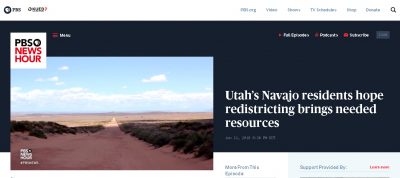
“On the Navajo Reservation… school buses must travel over miles and miles of dirt roads…. Navajo residents are hopeful that the redistricting, which affects both the county commission and the school board, might bring more resources their way.”
One of the interviewees, Curtis Yanito claimed that, “I know that there’s funds out there, but it just stops right there, where the border’s at. It doesn’t come this way.”
But in a Zephyr response to the PBS story we quoted Daniel McCool, a political scientist from the University of Utah. He stated that, “The conflict over the roads issue is typical of many of the service problems experienced by Utah Navajos. Government-provided services, or the lack of them, has been characterized for decades by a very clear game of pass-the-buck, and the roads are no exception to this.”
Who are the buck passers? Is it San Juan County? In the same Zephyr article we noted that:
“…because so many of the reservation roads are owned by the Bureau of Indian Affairs (BIA) or the Navajo Nation, the “buck passing” as McCool calls it, continues. Still San Juan County, until recently, did some maintenance of reservations roads and was reimbursed by the federal government. But those payments have declined in recent years. In August, the Navajo Division of Transportation announced its intent to take responsibility for all Class B roads currently maintained by San Juan County and convert them to Tribal Routes.”
And now, in 2019, Commissioner Maryboy and other Native American leaders in San Juan County want the county’s road department to take back the Class B road monies and reinstate the county as the caretaker of roads on the reservation.
Hank Stevens, the president of the Navajo Mountain Chapter appeared before the commission to state his concerns. He told Maryboy, Grayeyes and Adams:
“We have a situation where BIA and NDOT actually created a situation with our county roads at Navajo Mountain and it’s really impacting the community right now because we don’t have any maintenance being done to the county roads. NDOT and BIA have only established about 15 miles of road maintenance and that’s strictly blading the road. And once they blade the southern portion of Navajo Mountain, that’s their 15 miles right there. So then we have to wait for another cycle. And that’s my concern because the BIA and NDOT have actually jeopardized the community’s safety, especially in San Juan County.
“And I think we need to get back to our partnership with the county that was actually established by your predecessors. That partnership got us this far until BIA and NDOT decided to take over the roads… I’m willing to support the county and the commissioners in trying to expedite a partnership with San Juan County again in order to get the road maintenance back in its place. It’s impacting our school roads, our bus routes, and whatnot.”
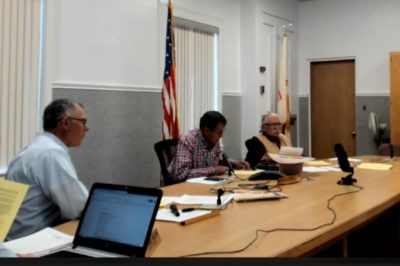
A discussion among the commissioners followed, with the county roads representative, Ben Musselman. Finally Commissioner Adams said, “Let’s claim those roads as B roads and bill the state for them. If somebody wants to come after us, we’ve got Kendall (the San Juan County Attorney).”
Kenneth replied, “Ya know, I’m at the point where that’s what we need to do because we’ve been dealing with the (Navajo) Nation, and you said with DC, maybe that’s another route we can do.” And he told Musselman, “You’ve been playing nice enough and I think it’s about time to circle the wagon now.”
—
The point of all this is not to disparage or criticize any of the principles in this story. Whether the Navajo Nation is guilty of ignoring the needs of Navajos living in San Juan County, or whether the allegations by Mr. Billie against Lyman and the Maryboys hold any credence, are matters for discussion at another time. As is the Navajo Department of Transportation’s alleged failing of its Utah tribal members when it comes to maintaining roads.
Whether Mark Maryboy’s sense of loss and grief over the death of Dr. Redd is misplaced, as Mr. Bailey suggested, is probably an unresolvable difference of opinion.
What is relevant and important is that for the past few years, San Juan County, Utah and its citizens, both Native and Anglo, have been forced to run a vicious gauntlet of public opinion. Hyperbole and assumption have defined not just the issues, concerns, and debates, but the participating citizens as well. Casual observers–and they now measure in the millions thanks to Bears Ears and national media campaigns– form opinions based on a disturbing lack of real information.
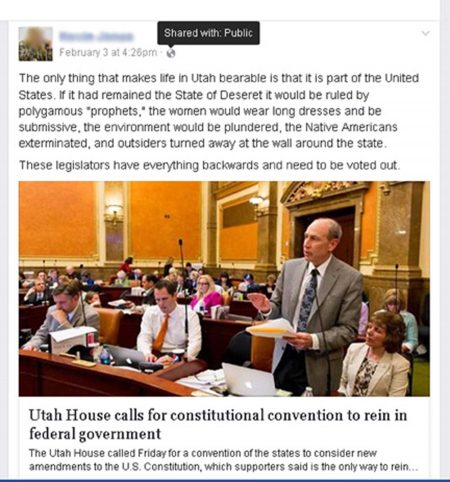
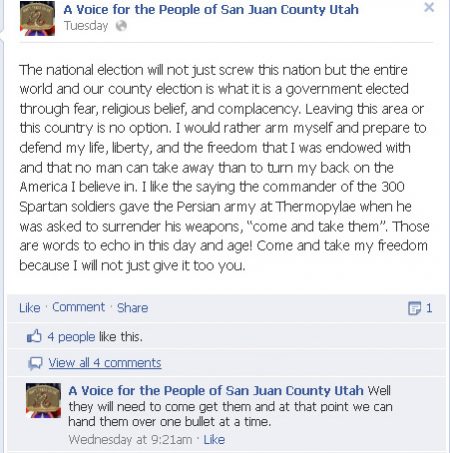
In 2019, there’s little difference between ‘news’ media and ‘social’ media, and as both sides play to their respective core audiences, facts almost become a liability. The drivers of public opinion want their followers to believe that there is Good and there is Evil and that absolutely nothing exists between those two extremes. Every issue and every involved person is defined in the harshest, most inflexible, black and white terms possible. Nuance doesn’t exist in San Juan County. But it should.
Because nothing…absolutely nothing is as black and white in San Juan County, Utah (or elsewhere for that matter) as the vast majority wants to believe it is. While it may be easier and even more lucrative (I’m thinking fund raising for “causes”) to define all these issues in such stark good and evil terms, it is simply not true.
Consequently, men like Kenneth and Mark Maryboy, on one supposed end of the political spectrum, and Phil Lyman, their ideological opponent, become caricatures of themselves. Sometimes it’s of their own doing, but often it’s exacerbated by those who choose to villainize or deify them. Whatever suits the needs of the Inflammatory Ones to advance their always polarizing agendas.
And please note I’m not trying to paint the Maryboys or Lyman in some kind of innocent heavenly glow. All of them have inflamed the fires of public opinion from time to time. Liberals see Lyman as the provocateur; Conservatives view the Maryboys similarly.
Recent San Juan County issues over national monuments, tribal rights, and contested elections have escalated the rhetoric. Lyman has contributed his fair share of hyperbole. Two years ago he complained that the Bureau of Land Management is “the Gestapo arm of this federal government,” a theme that runs through many of his public pronouncements.
But Maryboy has also painted the narrative with his own broad strokes. When he wrote in the Salt Lake Tribune that, “My Navajo relatives and Ute friends were shocked that our non-Native neighbors continued to desecrate our holy places and rob the gravesites of our ancestors,” his labeling did much to brand the general population. (In fact, 24 people were charged, less than 1% of the city’s Anglo residents. Ten pleaded guilty. Three committed suicide.)
Clearly, not all BLM employees exhibit “Gestapo” tactics; nor do all Anglo residents of San Juan County promote “grave robbing.” In fact, only a tiny fraction of both groups might harbor the kinds of beliefs that both men find so abhorrent.
Other misperceptions abound. While many white progressives have tried to spin the Maryboys as “traditional” Native Americans who eschew the destructive aspects of modern American Culture, the fact is, the Maryboys are very much players in that world. As we’ve already noted, Mark and Kenneth have worked to create a massive corporate entity to handle the oil revenues produced on the Utah side of the Navajo Reservation.
Mark is a “global security and political associate” of Capital Link World Corp, based in Canada. He is the principal of Maryboy Management Group, “a key strategic associate and joint venture partner with Capital Link World Corp. and has a very influential Navajo owned business. Maryboy Management Group Inc. is a certified Navajo Nation business operator as a consultant in many areas of expertise including Asset Management Services.”
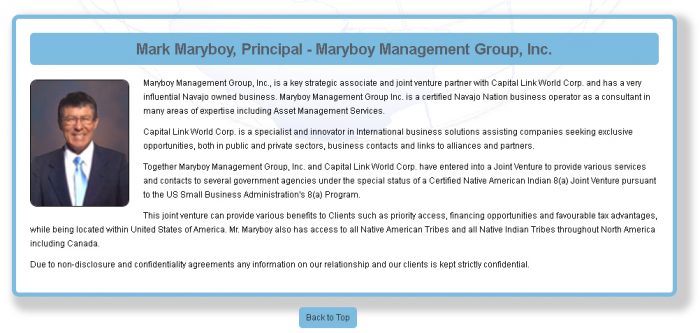
Kenneth Maryboy publicly supported the controversial “Grand Canyon Escalade,” a massive tourist development that was planned on Navajo lands near the Confluence of the Colorado and Little Colorado Rivers.
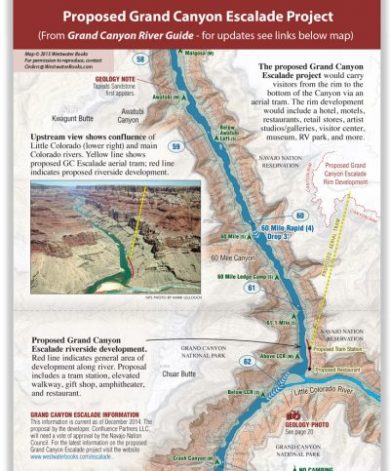
The development’s main draw was a gondola tramway from the canyon rim carrying visitors to a location near the canyon floor” But it also called the future development of hotels, and “a themed cultural and historical, recreation, arts, events, education, dining and shopping experience.” The Escalade would be visible from the eastern edges of Grand Canyon National Park. The project was opposed by most Navajos and even the Grand Canyon Trust expressed concerns. But Maryboy supported the plan. Reporter Marley Shebala posted in the Gallup Independent that:
“Former Council Delegate Kenneth Maryboy, of Aneth, Utah, informed the Naa’bik’iyati’ Committee that the Northern Navajo Medicine Men’s Association appointed him as its chairman and that the Navajo Medicine Men’s Association supported the Escalade.
The Escalade was later stopped by the Navajo Nation.
Likewise, Phil Lyman has railed against Industrial Tourism and its ill effects; in a recent post he wrote:
“I just hope that people will wake up to the fact that the Bears Ears National Monument is the opposite of protection and was appropriated by CLF and Patagonia. The industrialized tourism machine masquerades as environmentalist saviors when in reality they hate America, are funded by people who hate America, and attracts people and news paper editors who hate America.”
Yet, as The Zephyr noted last October, then-commissioner Lyman voted to support a massive increase in its tourist marketing budget and a multi-media promotional campaign ironically called, “Make it Monumental.” The county’s economic development director promised, with Lyman’s full-throated support, that if the Monumental campaign catches fire and brings more tourists to the county, the next tourism investment will seek to refine its message and even pursue “international” promotions.
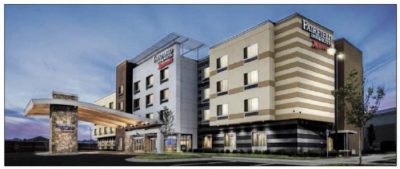
And Lyman is a major investor and promoter of a proposed multi-million dollar “Fairfield Marriott” hotel in Blanding. He even sought tax relief via a “community reinvestment area” plan that would have directed future tax payments to benefit his project, at the expense of other county taxing entities (The San Juan County school district unanimously opposed the plan)
—
Nothing…is as black and white as we want it to be.
The desire of all of us to see the world in stark “good vs evil” terms is understandable. The urge to simplify its complexities and contradictions almost feels necessary at times, just to keep our heads from exploding, or our hearts from breaking.
But at a time when access to real information and articulate debate should be relatively easy, it’s bewildering to acknowledge how much of our public discourse is based on one-sided diatribes, meaningless memes, and 140 character tweets. Are we so polarized that we simply can’t handle information that conflicts with our own preconceptions? Are we all so determined to be “right” that facts simply don’t matter anymore? Or are we just too indifferent, disengaged…or lazy…to seek the truth?
My own journey from who I used to be to who I am now, over the span of several decades, is littered and potholed with my own biases, prejudices and assumptions. And I don’t doubt that I’m still guilty of being swayed by them even now. But I’m fighting them as best I can.
For me, the ultimate truth in all this is that there is no ultimate truth. There are no cold, hard answers that will fully satisfy anyone, no matter what the subject. And there certainly aren’t answers that will allow any of us to feel fully vindicated or, for that matter, condemned. We don’t live in that kind of world any more. I wish we did.
All we can do is try to collect as much information as we can, separate the facts from the hysteria and try to honestly examine what’s left. So maybe the conflicting message between Maryboy and Lyman is a lesson for all of us. It’s…you know…complicated.
Jim Stiles is Founder and Co-Publisher of the Canyon Country Zephyr.
To comment, scroll to the bottom of the page.
Don’t forget the Zephyr ads! All links are hot!
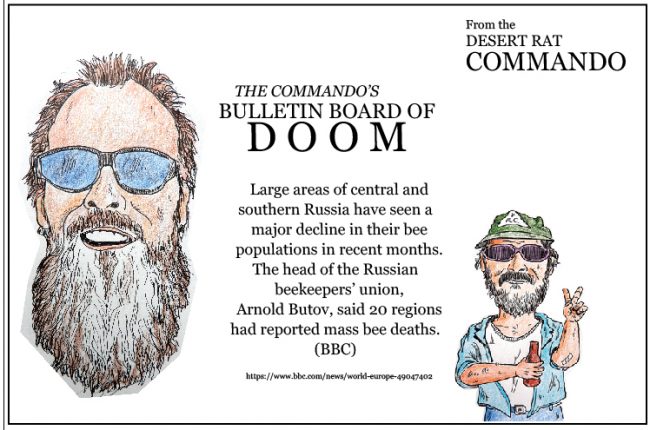
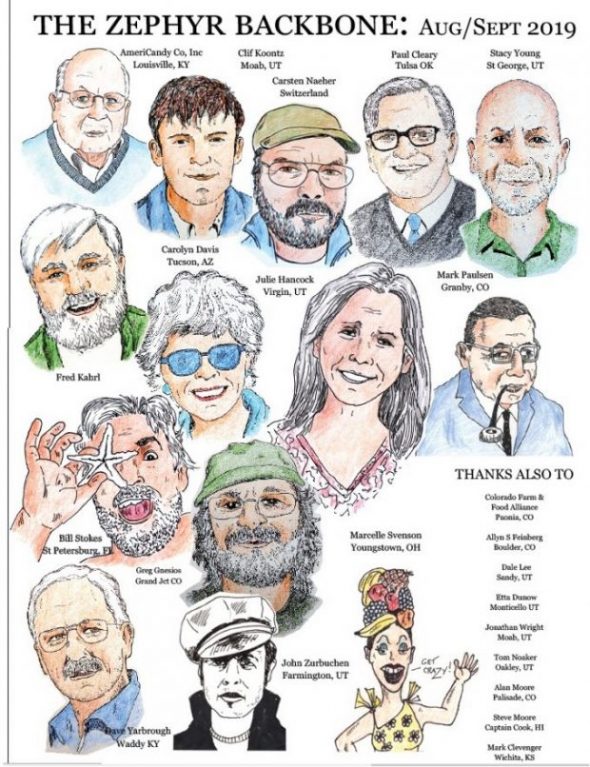




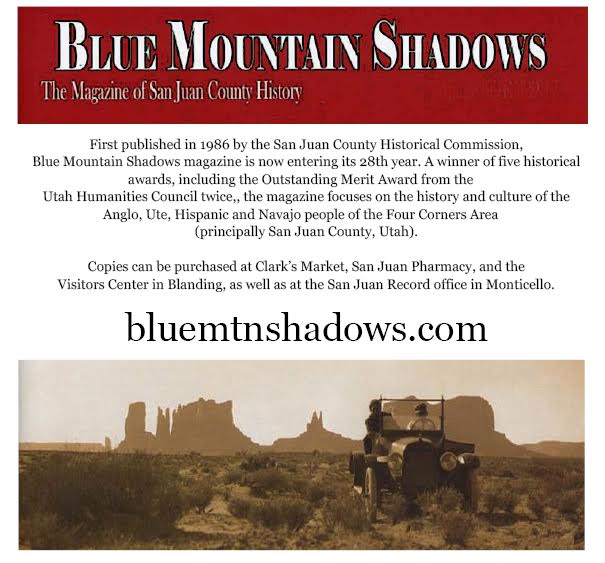


In this era of polarization and a scarce supply of nuance in both journalism and social media, thanks for reminding us that things don’t always appear as they seem in the newspaper or on social media and nuance is not a dirty word.
Jim,
“A man with an experience is never at the mercy of a man with an opinion.” – Pastor L. H. Hardwick. I couldn’t tell if you were attempting to simplify complicated issues or complicate simple issues. Yes Kenneth Maryboy and I go way back. We are the same age, and he is one of my oldest and dearest friends. It is funny what bonding takes place while making pudding in 7th grade home ec class. Mark Maryboy is older and our dealings together are more recent, only the last 30 years or so. Did you know, there is a precedent-setting Utah Tax case that was won by Mark Maryboy and his fresh-out-of-BYU accountant. That also tends to build trust. Why he decided to call me a desecrator of graves is a mystery, and that tends to destroy trust. We traveled the country together and spent hours driving together. He is one of the most interesting people I have ever worked with. I even persuaded him to take the director spot of UNDC in 2008 when it was all but bankrupt. The motives were not selfish, but who would believe that? UNDC used the roughly $4 million in annual oil royalty money to obtained matching grants which brought them to a budget of more than $16 million a year. That was back in 1989 when $16 million was a lot of money. The mismanagement came after the professionals were dismissed in favor of Navajo management. Not that Navajos can’t manage, but the focus changed from development to something else. Outside consultants took what they could and attorneys did the rest. Another long-time friend and classmate of mine, John Ray Billie, told me that he would rather see the trust fund put on a rocket ship and sent to the moon than to have the conflict that seemed to come with it. It was that comment that convinced me to stop trying to lobby for local management and to let the state take it back over. He is correct; I am a non-native CPA. How much does the State get in matching grants for the fund? Zero. They keep it locked in the PTIF, safe from any possible accusations of mismanagement. Losing UNDC was one of the greatest disservices ever done to the Utah Navajos. But money makes people crazy and UNDC’s downfall was its tremendous success in leveraging the royalty resource. Maybe it is complicated for people to comprehend spending time and money simply to improve one’s communities, but that is exactly what Mark has tried to do, and it is exactly what I have tried to do. I don’t know why people think that their own motives are pure, but can’t comprehend someone else’s being pure as well. But if people of goodwill wait for the approval of the crowd, they would never do anything. So… whatever.
To summarize: 1. Industrialized tourism is your term. 2.The BLM IS the Gestapo arm of the federal government (I have experienced too much to fall for measured opinions to the contrary.) (I am sure that there were some very good people employed by the Russian Gestapo, just as there are with the BLM, but the agency is the current-day Gestapo), and 3. You should really learn what the Blanding CRA is before you call it a benefit to “my” project at the expense of other taxing entities. You have it backwards – and it is not complicated. Plus the CRA is not past tense, it is alive and affecting very positive development for Blanding. It sends the message that Blanding is interested in growing the economy, even if the school board is not.
I do like your articles, even if they provoke long rambling comments.
As someone new to the region (sorry to encroach on your solitude Jim) I appreciate the nuance that these articles bring to issues that do seem to be boiled down to right and wrong, left and right, good and bad all too often. Getting some of the history of the Maryboy brothers I think is invaluable to understanding the role they play today in the region. Additionally, as someone who grew up in an environmentalist household, I appreciate your complicating issues of conservation, calling out the hypocrisy the is rife among our ranks. Calling for no new extraction sites while driving to get to preserved areas to recreate certainly requires further examination.
To be transparent, I quite like national monuments, and tend to recreate on BLM lands quite frequently. I struggle to understand how Phil can see them as a gestapo, especially as someone whose Jewish ancestors fled the actual gestapo in Germany all those years ago. They even allow oil and gas extraction, cattle grazing and other economic activities on their lands, albeit at slightly reduced rates than would be allowed on privately held lands perhaps. Granted, the Blanding raids did seem rather extreme, but I’d hardly call the antiquities act unreasonable. The gestapo made it ilegal for my ancestors to exist, the BLM has just made it ilegal to collect items that people have no rightful claim to. Perhaps Phil would be kind enough to explain his view of the BLM to me in case I have missed some parallel between them and the gestapo??
Jim,
You know I’m a big fan…and I’m also a right-winger. As you so beautifully illustrate in this piece, nothing is black & white, and that goes for the way “right” and “left” view the controversies and personalities dominating news and narratives in San Juan County. For instance–I love you Phil–but I disagree with Phil Lyman on a couple of points including growth vs “locking up the lands.” Like Phil, I’m a capitalist and believe resources and lands should be used to benefit those closest to them who have families and futures at stake, but unlike Phil, I oppose unfettered the kind of urbanism now sweeping our small towns like a cement and steel tsunami. In that sense I’m a conservative conservationist, and as a native of Moab, I always have been.
I want to use this opportunity to defend my fellow right-wingers and many left-wing friends as well. For the most part those of us who know and love this part of Utah with a deep and protective affection, live lives that are incredibly nuanced, where friends are friends because their hearts are good and they wish to do no harm.
That being said, ideology does play a role in the dysfunction and controversies strangling San Juan County, but it’s not so much the ideologies at fault as the vectors spreading them–those vectors being activists and urbanites who have moved here with the cynical goal of “fundamentally transforming” the region into a playground for the rich.
Few natives of southeastern Utah, right or left, brown or white skinned (sunburned-pink in my case), want our home to become a federally-run tourist attraction. But the big-money activists–and the money is in the billions in some cases–along with the urban transplants who resent we protective natives, are either directly advocating that end, or promoting it indirectly via national monuments and other restrictive and well-publicized designations.
When you distill all the controversies down to their basic elements, what you get are those people who want to conserve–different than “preservationism”–that which is special about this country, and those who wish to exploit its beauties, as well as its people, for money and power.
This is great writing Jim. You engaged my heart as well as my mind.
Mr. Stiles, the ONLY thing that is black and white in life is this: Follow the Money.